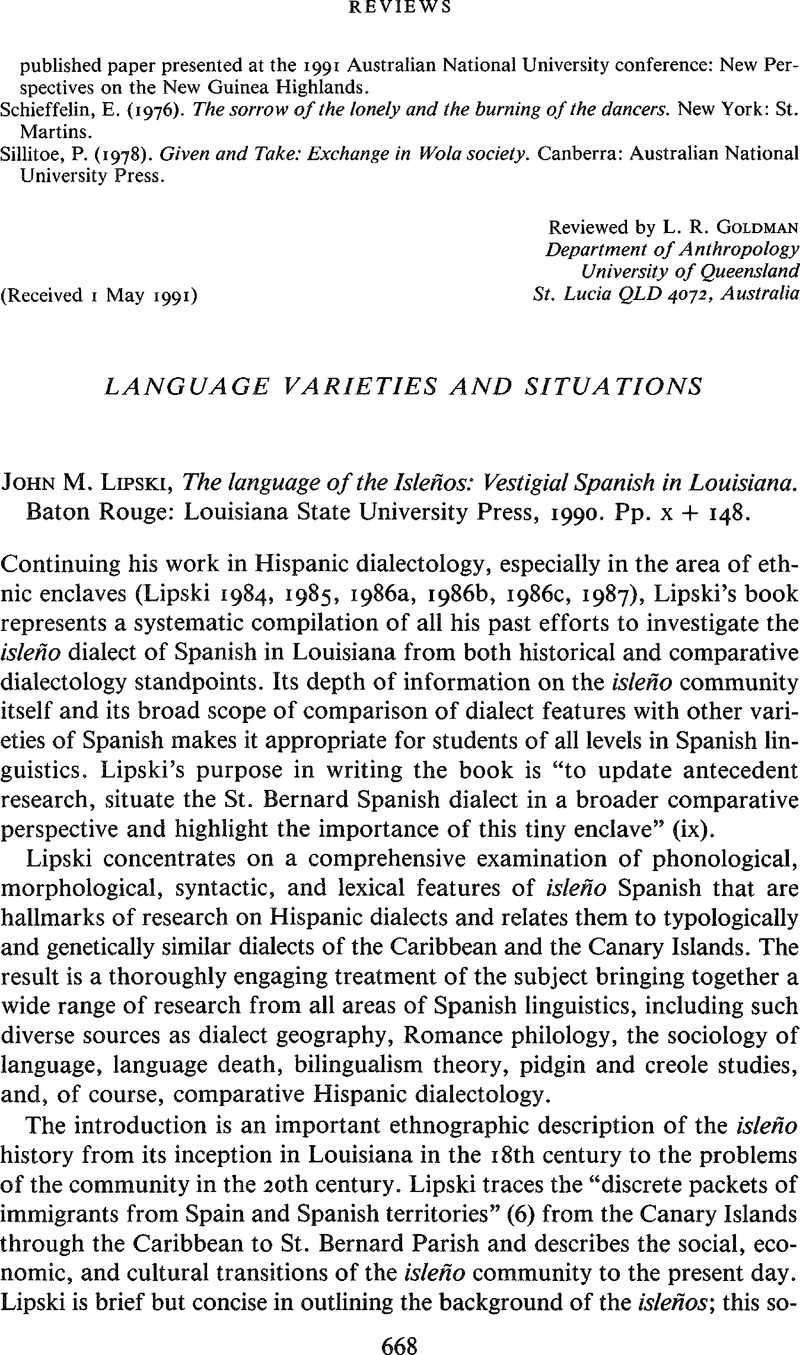No CrossRef data available.
Article contents
Language Varieties and Situations - John M. Lipski, The language of the Isleños: Vestigial Spanish in Louisiana. Baton Rouge: Louisiana State University Press, 1990. Pp. x + 148.
Published online by Cambridge University Press: 05 January 2009
Abstract
An abstract is not available for this content so a preview has been provided. Please use the Get access link above for information on how to access this content.

- Type
- Book Review
- Information
- Copyright
- Copyright © Cambridge University Press 1991
References
REFERENCES
Jon., Amastae (1989). The intersection of s-aspiration/deletion and spirantization in Honduran Spanish. Language Variation and Change 1:169–83.Google Scholar
Campbell, Lyle, & Muntzel, Martha C. (1989). The structural consequences of language death. In Dorian, Nancy C. (ed.), Investigating obsolescence: Studies in language contraction and death. Cambridge: Cambridge University Press. 181–96.CrossRefGoogle Scholar
Henrietta., Cedergren (1973). The interplay of social and linguistic factors in Panama. Unpublished Ph.D. dissertation, Cornell University.Google Scholar
Hochberg, Judith G. (1986). Functional compensation for /s/ deletion in Puerto Rican Spanish. Language 62:609–21.CrossRefGoogle Scholar
Lipski, John M. (1983). La norma culta y la norma radiófonica: /s/y/n/ en español. Language Problems and Language Planning 7:239–62.CrossRefGoogle Scholar
Lipski, John M. (1984). The Spanish of Malabo, Equatorial Guinea, and its implications for Hispanic dialectology. Hispanic Linguistics 1:69–96.Google Scholar
Lipski, John M. (1986a). Bozal Spanish: Existence and coexistence. Journal of Pidgin and Creole Languages 1:171–203.CrossRefGoogle Scholar
Lipski, John M.. (1986b). El valle de Chota: Enclave lingüistico afroecuatoriano. Anuario de lingüistico hispánica 2:153–76.Google Scholar
Lipski, John M.. (1986c). The speech of the negros congos of Panama: An Afro-Hispanic dialect. Hispanic Linguistics 2:23–47.Google Scholar
Lipski, John M. (1987). El dialecto español de Rio Sabinas: Vestigios del espafiol mexicano en Luisiana y Texas. Nueva revista de filologia hispánica 35:111–28.CrossRefGoogle Scholar
Roxana, Ma, & Eleanor, Herasimchuk. (1979). The linguistic dimensions of a bilingual neighborhood. In Fishman, Joshua A., Cooper, Robert L., & Ma, Roxana (eds.), Bilingualism in the barrio. Bloomington: Indiana University Press. 347–464.Google Scholar
MacCurdy, Raymond R. (1959). A Spanish world-list of the “brulis” dwellers of Louisiana. Hispania 42:547–554.CrossRefGoogle Scholar
Sidney., Mintz (1971). The socio-Hispanic background to pidginization and creolization. In Hymes, Dell (ed.), Pidginization and creolization of languages. Cambridge: Cambridge University Press. 481–96.Google Scholar
Rickford, John. (1977). The question of prior creolization in Black English. In Valdman, A. (ed.), Pidgin and Creole linguistics. Bloomington: Indiana University Press. 190–221.Google Scholar
Terrell, Tracy D. (1978). Sobre la aspiracion y elisión de la /s/ implosiva y final en el español de Puerto Rico. Nueva revista de filología hispánica 27:24–38.CrossRefGoogle Scholar
Terrell, Tracy D. (1982). Current trends in the investigation of Cuban and Puerto Rican phonology. In Amastae, Jon & Elías-Olivares, Lucía (eds.), Spanish in the United States: Sociolinguistic aspects. Cambridge: Cambridge University Press. 47–70.Google Scholar


